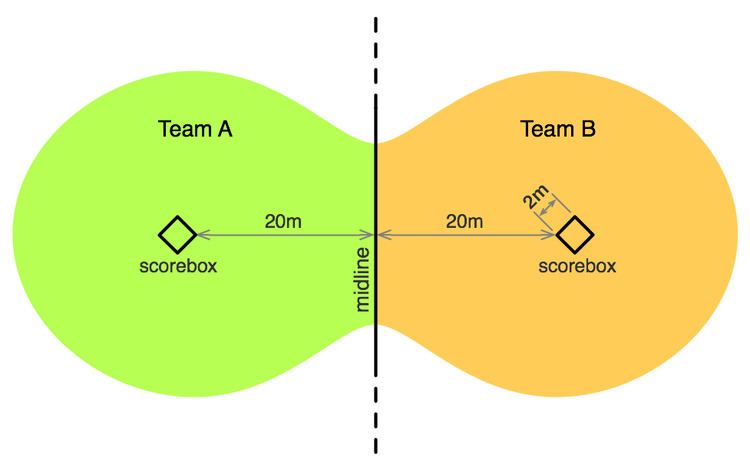 | ||
Schtick disc (or simply schtick) is a limited-contact team sport played with two or more flying discs (Frisbees), and although considered a variant of ultimate disc, shares little similarities beyond the use of discs. For instance, schtick players are permitted to run whilst holding the disc.
Contents
The sport is known for its relaxed and friendly style of play, and the unusual strategic dimension added by the use of multiple play objects. Additionally, the allowance of running with the disc and generally more forgiving operations of play than most team sports makes the game more fun and accessible to players of varied abilities than traditional ultimate.
Origins
The game was conceived and pioneered by the a group of friends from Delaware, USA and/or graduates of Rice University, and was first played in 1994 on Assateague Island. It has since been played throughout the US and in Australia as well, having been featured at Sydney's Longest Day Beach Ultimate Tournament since 2001.
Description of playing field
Schtick is played on a somewhat unconventional field. A midline bisects the globe (i.e. the Earth) into two territories - meaning there are no out of bounds or sidelines. Each territory has a 2-metre square scoring box located 20 metres from the middle line. These scoring boxes are often arranged in a diamond shape to the midline, but square-on is equally acceptable.
Typically a football half-way line is used to mark the midline, as precise knowledge of the line's position is frequently required for tactical play. Scoreboxes can be marked out by any means that is easily visible, though traditionally bundled socks or knotted rags have been used.
Operations of play
Players are divided into equal teams of 4 to 10, with each team defending their associated territory and scorebox. No player at any time may enter either scorebox or the airspace above them. Two discs are used during the game, and a round of play begins with each team holding one of the discs. Players are permitted to run with the disc, but a player may be "tagged" while standing in their opponents territory, in which case a handover of the disc occurs. Any time a disc touches the ground, it becomes the possession of the team whose territory it lands in. A team scores a point when a disc comes to rest in their opponents scorebox - discs that land in, then roll out do not score and result in a turnover. When a point is scored, the round ends and each team must return to their own territory for the beginning of the new round.
Strategy and tactics
Due to the unusual dynamic introduced by playing with multiple discs, Schtick can be a very intense and tactical game. Play typically moves between three states - totally offensive when your team is in possession of both discs, totally defensive when the opposing team is in possession of both discs, and a mixed state in which each team is in possession of a disc.
Offensive plays typically involve passing the disc to teammates within range of the opposing team's scorebox, or simply attempting to "make a run for it" by flanking the opposition with both discs. If at any stage an offensive player carrying the disc in the opposing territory is threatened by the defence, they may choose to throw the disc back towards their own territory - commonly referred to as "backing out".
Defensive play typically involves covering the scorebox and attempting to tag any opposition players that enter your territory.
In the mixed state, a number of tactics may be employed, such as attempting to retrieve the second disc before making an offensive play. This will often result in what's referred to as a mexican stand-off, where both teams are unwilling to make an offensive move. Players will often attempt to confuse members of the other team by hiding the disc or with similar forms of subterfuge (which is perfectly legal).
